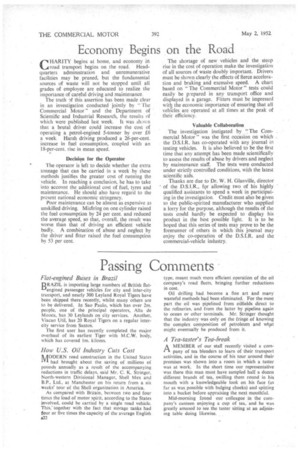Economy Begins on the Road
Page 24

If you've noticed an error in this article please click here to report it so we can fix it.
CHARITY begins at home, and economy in road transport begins on the road. Headquarters administration and unremunerative facilities may be pruned, but the fundamental sources of waste will not be stopped until all grades of employee are educated to realize the importance of careful driving and maintenance.
The truth DI this assertion has been made clear in an investigation conducted jointly by —Hie Commercial Motor" and the Department of Scientific and Industrial Research, the results of which were published last week. It was shown that a brutal driver could increase the cost of operating a petrol-engined 5-tonner by over £6 a week. Harsh driving produced a 26-per-cent. increase in fuel consumption, coupled with an 18-per-cent. rise in mean speed.
Deeisign for the Operator The operator is left to decide whether the extra tonnage that can be carried in a week by these methods justifies the greater cost of running the vehicle. In reaching a conclusion, he has to take into account the additional cost of fuel, tyres and maintenance. He should also have regard to the present national economic stringency.
Poor maintenance can be almost as expensive as unskilled driving. Misfiring on one cylinder raised the fuel consumption by 24 per cent. and reduced the average speed, so that, overall, the result was worse than that of driving an efficient vehicle badly. A combination of abuse and neglect by the driver and fitter raised the fuel consumption by 53 per cent. The shortage of new vehicles and the steep rise in the cost of operation make the investigation of all sources of waste doubly important. Drivers must be shown clearly the effects of fierce acceleration and braking and excessive speed. A chart based on " The Commercial Motor" tests could easily be prepared in any transport office and displayed in a garage. Fitters must be impressed with the economic importance of ensuring that all vehicles are operated at all times at the peak of their efficiency.
Valuable Collaboration The investigation instigated by ", The Commercial Motor" was the first occasion on which the D.S.I.R. has co-operated with any journal in testing vehicles. It is also believed to be the first time that any attempt has been made scientifically to assess the results of abuse by drivers and neglect by maintenance staff. The tests were conducted under strictly controlled conditions, with the latest scientific aids.
Thanks are due to Dr. W. H. Glanville, director of the D.S.I.R., 19r allowing two of his highly qualified assistants to spend a week in participating in the investigation. Credit must also be given to the public-spirited manufacturer who supplied a lorry for the purpose, although the results of the tests could hardly be expected to display his product in the best possible light, It is to be hoped that this series of tests may prove to be the forerunner of others in which this journal may enjoy the co-operation of the D.S.I.R. and the commercial-vehicle industry.




















































































